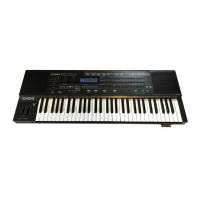•
VCA
(Voltage Controlled Amplifier)
This circuit controls the volume
of
the sound cr-eated by the VCO and VCF.
Determines
the
pitch
of
the
sound.
vco
Determines
the
timbre.
VCF
,-------------4
Determines
the
volume
of
the
sound.
VCA
•,
(Output)
.
Keyboard
I
e----------~
,
.........
Sound
signal
,.
control
sign11I
I
LFO
L
________________
_
EG
· Gate signal
Oscillator used
for
modulation
Determines
the
envelope curve
of
the waves
J J
• EG (Envelope Generator)
Controls
the
change over
tim•e
of
the volume, timbre etc.;
in
other words the envelopes. The basic envelope
curve consists ·
of
th
·e four elements shown
in
the diagram bJ low which can
be
controlled . independently.
The
EG
block
is
thus
capable
of
er.eating a great variety
of
curvb
s.
. . _
_..
,,
'
. .
- A
----
1
I
Attack
'-time
I
I
I
I
I
I
Key On
•
LFO
(Low
Frequency Oscillator)
o-
I I
: Release I
1
time--l
I
,fl/
• I
I
Sustain I
level I
I
Time
As this term indicates,
the
LFO
is
an oscillator operating
at
low frequencies. It can
be
used
to
control various
other
blocks
to
create such effects as vibrato.
-
The
basic
structure
and functions
of
an analog synthesizer:
'I
• VCO: Determines pitch
_(basic
waveform) •
EG:
Determines the.envelope
• VCF: Creates the timbre •
LFO:
Used for various effects
• VCA: Determines sound volume
'l
• k
I.\
¥
The
above
is
meant
only
as
a general idea
of
how
an analog synthesizer works.
Of
course, there are
considerable differences according
to
the manufacturer anct model.
-6~-

